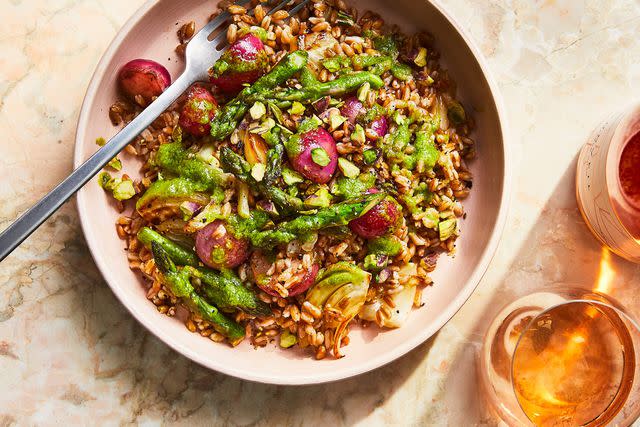The #1 Nutrient to Lower Blood Sugar Levels, According to a Diabetes Expert
Find out how this powerhouse nutrient lowers blood sugar to help you stabilize those spikes.
Reviewed by Dietitian Maria Laura Haddad-Garcia
Are your blood sugar levels on a roller-coaster ride? Diabetes experts say there's a critical nutrient that could help stabilize that wild journey, and it's probably not what you'd expect. Fiber is one of the most essential nutrients in the battle against blood sugar spikes. And with over 37 million Americans grappling with diabetes, per the National Institute of Diabetes and Digestive and Kidney Diseases, finding effective strategies to manage blood sugar spiking is critical.
Here, we explore fiber's impact on blood sugar levels, offer practical tips for incorporating this powerhouse nutrient into your daily meals, and cover other essential nutrients that join the fight for stable blood sugar. Let's dive in.

Pictured Recipe: Farro & Vegetable Bowls with Lemon-Shallot Herb Sauce
How Fiber Helps with Blood Sugar
Dietary fiber can be categorized into two main types: insoluble and soluble fiber. These categories are based on how fiber interacts with water and impacts your body. According to a 2022 study in Foods, soluble fiber, in particular, is beneficial for helping regulate blood sugar because it forms a gel-like substance when dissolved in water, slowing down the digestion and absorption of carbohydrates.
When you eat fiber-rich foods, like whole grains, legumes and certain fruits and vegetables, the sugar from these foods is released into your bloodstream more gradually, preventing those pesky sugar spikes and crashes.
Erin Palinski-Wade, RD, CDCES, a registered dietitian and author of 2-Day Diabetes Diet, tells EatingWell, "Dietary fiber helps control blood sugar by slowing down the absorption of sugar into the bloodstream, which can help prevent spikes and crashes in blood sugar and keep blood sugar in the target range. Fiber can also help to improve satiety and reduce appetite, helping with portion control at meals."
But fiber's blood-sugar-balancing magic doesn't stop there. Palinski-Wade adds that diets rich in fiber have also been shown to improve body composition and reduce visceral fat (or belly fat), per a 2021 study in the Journal of Cachexia, Sarcopenia and Muscle. And according to a 2020 study published in Diabetes, Metabolic Syndrome and Obesity, excess visceral fat can increase insulin resistance, leading to elevated blood sugar levels. Increasing your fiber intake can help reduce visceral fat, improving blood sugar levels long term and reducing your type 2 diabetes risk.
Related: What Happens to Your Body When You Don't Eat Enough Fiber
3 Ways to Get More Fiber in Your Diet
1. Add Prunes to Your Diet
Prunes are more than a natural remedy for digestion—they're a fiber powerhouse. One serving of dried prunes provides around 3 grams of fiber, per the USDA, along with a sweet and delicious taste. Ensure you eat prunes whole instead of drinking prune juice, as the juice is typically void of fiber.
"Adding prunes to your meal plan can be a wonderful way to boost fiber, and it couldn't be easier to do," says Palinski-Wade. "This dried fruit can be enjoyed on its own, added to trail mix and salads, blended into smoothies, and even pureed and used as a sugar substitute in baked goods. Plus, research has found including five to six prunes daily can help prevent bone loss." Our Sokolatakia (Chocolate-Dipped Walnut-Stuffed Prunes) recipe is a delicious way to start.
2. Eat Fresh Avocado
Besides being good for your heart, avocados are packed with fiber. Just half of a medium avocado contains roughly 6 to 7 grams of fiber. Plus, avocado's versatility makes it an easy and nutritious addition to your diet. Spread it on whole-grain toast, toss it into salads, or blend it into a creamy green smoothie, such as Jason Mraz's Avocado Green Smoothie.
"Although avocado is a fruit, avocados don't contain sugar, and 79% of the carbohydrates found in them come from fiber," states Palinski-Wade. "Not only can the addition of avocado provide a good source of fiber, but replacing carbohydrates with avocado at a meal may further benefit blood sugar levels. One study found that including a half or whole avocado at breakfast decreased the participants' glucose and insulin compared to the control breakfast." The study referenced by Palinski-Wade was included in a 2021 review published in Nutrients.
3. Consume More Legumes
Incorporating more legumes into your meals is another way to supercharge your fiber intake. Beans, lentils and chickpeas are fiber-rich, boasting 6 to 8 grams of fiber per cooked cup. Create hearty soups, stews and Vegan Burgers with beans, or whip up a Whipped Hummus using chickpeas. Legumes add texture and flavor to your dishes while boosting your fiber intake.
The Bottom Line
When managing your blood sugar, fiber is the nutrient of choice. While it helps prevent sugar spikes and crashes by slowing the absorption of sugar into the bloodstream, fiber also aids in reducing visceral fat, a known risk factor for insulin resistance and elevated blood sugar levels.
Incorporating fiber into your diet doesn't have to be a chore—delicious options like prunes, avocado and legumes make it both easy and enjoyable. However, fiber isn't the only nutrient that can stabilize your blood sugar. Other blood-sugar-regulating nutrients include protein, chromium and magnesium. Eating a well-balanced diet rich in these essential nutrients is vital to keep your glucose levels steady and your health on track.
Related: The 9 Best High-Fiber Vegetables You Should Be Eating, According to a Dietitian
Read the original article on Eating Well.

